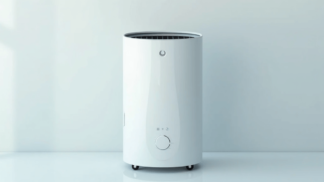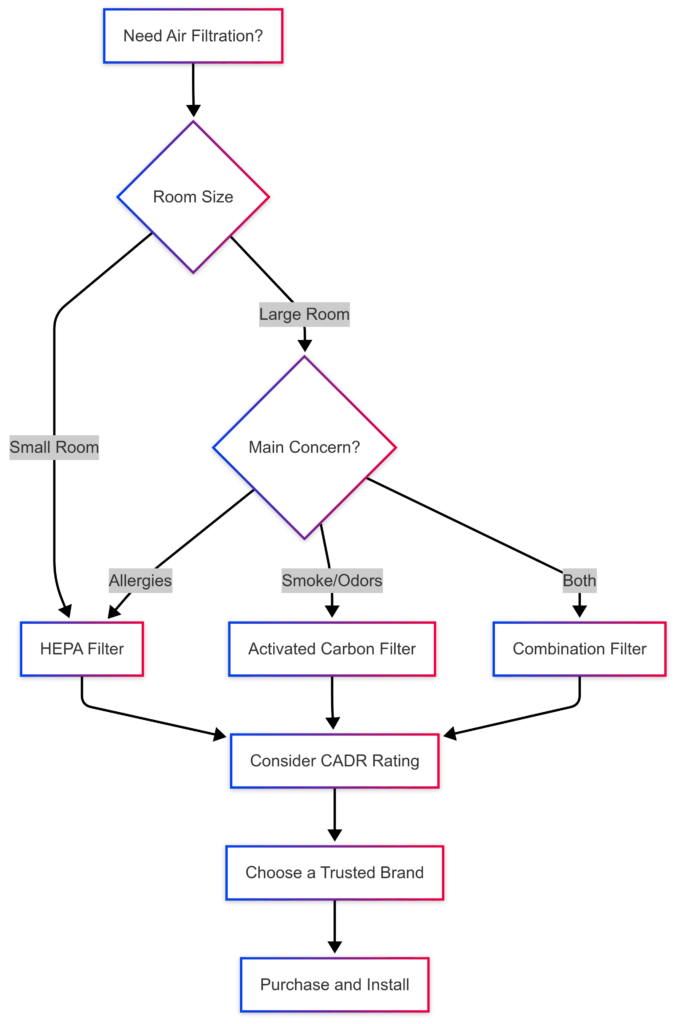
Household odors are a ubiquitous challenge faced by homeowners, stemming from a multitude of sources that can impact the comfort and overall well-being of occupants. These smells, ranging from the lingering aroma of last night’s dinner to the more persistent scent of pets or dampness, can be a source of frustration and even concern about indoor air quality. While traditional methods like opening windows or using air fresheners offer temporary relief, they often fall short of completely eliminating the underlying odor molecules.
In response to this common problem, smart air purifiers have emerged as a contemporary technological solution designed to improve indoor air quality, with a specific focus on odor control. These advanced devices go beyond basic air filtration by incorporating features such as wireless connectivity, a variety of sensors, and automated operation. This report aims to explore the ways in which these smart air purifiers can effectively assist in managing and eradicating the diverse range of household odors, providing a comprehensive understanding of their capabilities and benefits. For all your smart purification needs, consider checking out resources like FastFilters.com.
Unmasking the Culprits: Common Sources of Household Odors
The modern home is a complex environment where various activities and materials can contribute to the presence of unwanted odors. Identifying these sources is the first step in understanding how smart air purifiers can help.
The kitchen, often considered the heart of the home, is a significant source of diverse and frequently potent odors . Cooking activities, particularly frying and the use of strong spices, release a variety of aromatic compounds into the air . Burnt food can also generate acrid and persistent smells. Furthermore, the decomposition of food waste in refrigerators and trash cans produces a range of volatile organic compounds (VOCs) and gases, often resulting in unpleasant smells . Bacteria play a crucial role in this process, breaking down organic matter and releasing odoriferous byproducts . Even seemingly innocuous appliances like garbage disposals and dishwashers can become sources of odors if food scraps accumulate and decompose within them .
For pet owners, the presence of animals in the home introduces a unique set of odor challenges . Pet dander, shed skin cells, and urine are common sources of these smells . General pet odors can emanate from animal bedding and litter boxes. Pet hair can also trap odor-causing bacteria, further contributing to the overall smell of a home . These odors can be particularly persistent and require targeted filtration strategies.
Moisture-related issues are another significant contributor to household odors . Mold and mildew thrive in damp environments such as bathrooms, basements, and areas around water leaks . Their growth produces characteristic musty odors, which can permeate the entire home . Beyond the unpleasant smell, mold spores can also pose health risks, triggering allergies and respiratory problems .
Inadequate ventilation can also lead to the accumulation of odors indoors, resulting in a general stale smell . When air is stagnant, odor molecules produced from various sources remain trapped and concentrated within the living space . This lack of fresh air exchange allows odors to linger and become more noticeable over time.
The materials within a home can also be a source of odors . New furniture, paint, and building materials often release volatile organic compounds (VOCs) into the air, resulting in distinct chemical odors . Some cleaning products, while intended to freshen, can themselves leave behind strong chemical smells that some individuals find unpleasant .
Finally, the decomposition of organic matter can lead to very strong and unpleasant odors . This can include the smell of dead animals that may have perished in attics or walls, pest infestations such as rodents and insects, and general decomposition of food waste or other organic materials that may have gone unnoticed .
Decoding the Technology: How Air Purifiers Combat Odors
To understand how smart air purifiers can help with odor control, it is essential to grasp the fundamental principles of air filtration and the specific technologies employed to target different types of airborne pollutants.
A key distinction in air filtration is the difference between particulate matter and gaseous pollutants . Particulate matter includes solid particles and liquid droplets suspended in the air, such as dust, pollen, and pet dander. Gaseous pollutants, on the other hand, consist of individual molecules and include volatile organic compounds (VOCs) and the molecules that cause odors . Standard High-Efficiency Particulate Air (HEPA) filters are highly effective at capturing particulate matter . These filters are designed with a dense network of fibers that physically trap particles as small as 0.3 microns . However, due to the much smaller size of gas molecules, HEPA filters alone are not efficient at removing odors .
The primary technology used in air purifiers for effective odor removal is activated carbon filtration . Activated carbon is a specially treated form of carbon that is exceptionally porous, giving it a vast surface area . This large surface area allows it to effectively capture odor molecules through a process called adsorption . Adsorption occurs when molecules of a gas or liquid adhere to the surface of a solid . The more porous the activated carbon, the more surface space is available for these odor molecules to latch onto as air passes through the filter . Activated carbon can be derived from various carbon-rich materials such as coconut shells, coal, and wood . Air purifiers with activated carbon filters are effective at reducing a wide range of household odors, including those from cooking, pets, smoke, and many chemical fumes .
While activated carbon is key for odor control, other filtration methods found in air purifiers typically play a limited role in directly addressing smells. Pre-filters are designed to capture larger particles like dust and pet hair, primarily serving to extend the lifespan of the more delicate HEPA and activated carbon filters . Ultraviolet (UV) filters use UV light to kill bacteria and viruses but have a minimal impact on odor molecules . Ionizers release electrically charged particles into the air that can attach to and weigh down airborne particles, causing them to settle out of the air . While this can reduce particulate matter, ionizers are not particularly effective at removing gaseous odors and can also produce ozone as a byproduct, which is a known respiratory irritant .
The “Smart” Advantage: Enhancing Odor Control
Smart air purifiers incorporate advanced technologies that enhance their ability to manage and eliminate household odors compared to traditional models.
A defining characteristic of smart air purifiers is their connectivity and automation capabilities . These devices typically feature Wi-Fi connectivity, allowing them to connect to home networks and be controlled remotely via mobile applications . Many smart air purifiers can also integrate seamlessly into smart home ecosystems, working in conjunction with other connected devices and platforms .
A significant advantage of smart air purifiers is their ability to monitor air quality in real-time through built-in sensors . These sensors can detect various pollutants, including volatile organic compounds (VOCs) and particulate matter, which can serve as indicators of odor presence . Some advanced smart air purifiers even feature sensors specifically designed for odor detection . This continuous monitoring provides valuable data about the air quality within the home.
Leveraging the information from their sensors, smart air purifiers often feature an automatic mode that intelligently adjusts the fan speed based on the detected air quality . When the sensors detect a decrease in air quality, such as an increase in VOCs indicative of odors, the purifier will automatically increase its fan speed to enhance filtration . Conversely, when the air quality is good, the purifier can operate at a lower, quieter speed .
The ability to control smart air purifiers remotely through mobile applications offers significant convenience . Users can adjust fan speeds, set timers and schedules for operation, and even monitor the remaining lifespan of their filters from anywhere with an internet connection . This remote control capability allows for proactive odor management, such as starting the air purifier before arriving home to clear out any lingering smells.
Furthermore, many smart air purifiers can be integrated with popular voice assistants like Amazon Alexa, Google Assistant, and Apple Siri . This integration enables hands-free control of the device through voice commands . For instance, a user could simply ask their voice assistant to turn on the air purifier or adjust its fan speed. Some smart air purifiers can also be incorporated into automated smart home routines, such as turning on automatically when a user arrives home or as part of a “cleaning” scene.

Real-World Effectiveness: Smart Air Purifiers in Action
The effectiveness of smart air purifiers in controlling odors can be seen through various user experiences and case studies.
Many pet owners have reported significant improvements in air quality and a reduction in pet odors after using smart air purifiers . Models from brands like Levoit, Coway, Shark, Oransi, and Rabbit Air are frequently mentioned for their ability to tackle pet dander, urine smells, and general pet odors . User testimonials highlight the effectiveness of these devices in creating a fresher-smelling home, even with multiple pets .
Smart air purifiers have also proven effective in eliminating cooking smells, a common and often stubborn household odor . Users have shared experiences of air purifiers quickly clearing the air after cooking, even with strong-smelling foods like fried dishes and spices . The presence of an activated carbon filter is consistently highlighted as crucial for this odor removal capability .
For musty environments caused by mold and mildew, smart air purifiers can offer some relief . Reviews of specific models, such as the Blueair Blue Pure Max and the EnviroKlenz Mobile Air System, note their effectiveness in reducing musty odors . It is important to note, however, that while air purifiers can capture airborne mold spores and the volatile organic compounds they produce, they do not address the underlying moisture issues that cause mold growth .
Individuals sensitive to chemical odors from new furniture, paint, and cleaning products have also found smart air purifiers beneficial . Air purifiers with a focus on VOC removal, often featuring a substantial amount of activated carbon, are recommended for this purpose . User experiences suggest that these devices can help create a more comfortable environment by reducing the intensity of chemical smells.

Making the Right Choice: Selecting a Smart Air Purifier for Odor Control
When selecting a smart air purifier with the primary goal of odor control, several key features should be carefully considered.
The presence and capacity of the filters are paramount . For effective odor removal, the air purifier should include both a HEPA filter to capture particulate matter and a significant amount of activated carbon to adsorb odor-causing gases . The quantity and quality of the activated carbon are particularly important, as a larger and more porous carbon filter will have a greater capacity for odor adsorption and will remain effective for a longer period . You can often find detailed filter specifications on websites like FastFilters.com.
The Clean Air Delivery Rate (CADR) is another crucial factor to consider, as it indicates the volume of filtered air the purifier can deliver per minute and its suitability for different room sizes . Users should select a purifier with a CADR rating appropriate for the size of the room where it will be used to ensure effective odor removal .
The “smart” features of the air purifier can significantly enhance its odor control capabilities. Built-in air quality sensors allow the device to automatically detect the presence of odors and adjust its operation accordingly . Mobile app control provides convenience by allowing users to manage the purifier remotely and set schedules for operation, enabling proactive odor control . Many smart air purifiers with these features are available from retailers and online specialists.
Practical considerations such as noise levels and energy efficiency should also be taken into account . For use in bedrooms or other quiet areas, a model with a low noise level and a sleep mode is desirable . Choosing an energy-efficient model is also important, especially if the purifier will be running continuously .
Finally, the ongoing costs associated with filter replacement and maintenance should be considered . Activated carbon filters may require more frequent replacement than HEPA filters, particularly in environments with strong odors. The cost and availability of replacement filters, often found at places like FastFilters.com, should be factored into the overall purchase decision .
| Filter Type | Particle Removal (HEPA) | Odor Removal (Activated Carbon) | Other Considerations | |
|---|---|---|---|---|
| HEPA | Excellent | Minimal | Standard for particle removal. | |
| Activated Carbon | Minimal | Excellent | Key for odor, VOC, and gas removal. Capacity varies. Requires periodic replacement. | |
| Pre-Filter | Captures large particles | Minimal | Extends the life of other filters. Often washable. | |
| UV-C Light | Targets microorganisms | Minimal | May help with mold and bacteria on the filter. Potential ozone production. | |
| Electrostatic/Ionic | Can remove particles | Minimal | May produce ozone. Less effective against large pollutants. |
Optimizing Performance: Best Practices for Using Smart Air Purifiers for Odor Control
To maximize the effectiveness of a smart air purifier for odor control, proper usage and maintenance are essential.
Strategic placement of the air purifier within the room can significantly impact its ability to capture odors . Placing the unit in a central location allows for optimal air circulation throughout the space . When possible, positioning the air purifier near the primary source of the odor, such as in the kitchen near the stove or in a living room where pets spend most of their time, can improve its efficiency . Elevating the device slightly off the floor can also enhance air intake and output . It is advisable to avoid placing the air purifier in obstructed areas, such as behind furniture, or near sources of heat or excessive moisture, which can hinder its performance or damage the unit . For larger, multi-room homes, using multiple air purifiers or a single, more powerful unit strategically placed in a central area may be necessary to achieve comprehensive odor control .
Regular filter maintenance is crucial for ensuring the long-term effectiveness of the smart air purifier . Dirty filters restrict airflow and reduce the purifier’s ability to effectively filter the air . Activated carbon filters have a finite capacity to adsorb odor molecules and will eventually become saturated, requiring timely replacement to maintain odor removal efficiency . General guidelines suggest replacing activated carbon filters every 3 to 6 months and HEPA filters every 6 to 12 months, but these intervals can vary depending on usage and the severity of odors . Pre-filters, which capture larger particles, should be checked and cleaned (often by vacuuming) more frequently, typically every 1 to 3 months . Remember to source your replacement filters from reputable suppliers like FastFilters.com to ensure optimal performance.
Smart air purifiers work best as part of a broader strategy for odor control . Combining their use with good ventilation practices, such as opening windows and using exhaust fans, can help to remove stale air and reduce the overall concentration of odors . Other odor reduction techniques, such as regular cleaning to remove odor sources, using odor absorbers like baking soda or vinegar, and addressing the root cause of the odor directly, should also be implemented . It is generally not recommended to rely solely on air fresheners or diffusers, as these products typically mask odors with other scents rather than eliminating the odor molecules themselves . While ozone generators are another method for odor removal, some sources advise against their use in residential settings due to potential health risks associated with ozone production .
A Breath of Fresh, Smart Air
Smart air purifiers offer a valuable and technologically advanced solution for tackling the pervasive problem of household odors. Their ability to combine effective filtration, particularly through the use of activated carbon, with intelligent features like real-time monitoring and automated operation provides a significant advantage over traditional odor control methods. By selecting a model with the appropriate filter types and capacity, as well as considering factors like CADR, noise level, and energy efficiency, homeowners can find a smart air purifier that meets their specific needs. Resources like FastFilters.com can assist in finding the right purifier and replacement filters.
The convenience of remote control and integration with smart home ecosystems further enhances the user experience, allowing for proactive and seamless odor management. User experiences across various odor sources, including pets, cooking, mold, and chemical fumes, indicate that smart air purifiers can be highly effective in improving indoor air quality and creating a more pleasant living environment. However, to optimize their performance, it is crucial to follow best practices for placement and to maintain the filters regularly. Combining the use of a smart air purifier with good ventilation and addressing the underlying sources of odors will provide the most comprehensive approach to achieving a fresh and healthy indoor atmosphere.
The field of smart air purification is continuously evolving, with potential advancements in sensor technology, artificial intelligence for automation, and the development of even more efficient filter materials. These future innovations promise to offer even more sophisticated and user-friendly solutions for odor control, further solidifying the role of smart air purifiers in creating healthier and more comfortable homes.

